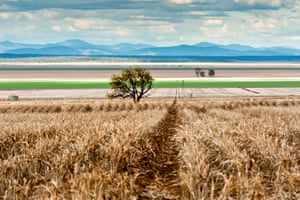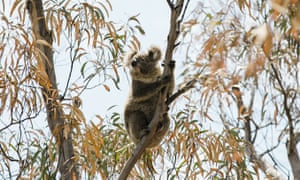Survey by Shenhua environmental consultant shows decline of 87% in
koala numbers since 2012-13, as campaigners plead for impact of
bushfires to weigh on mine conditions
Koalas on the site of the planned Shenhua Watermark coalmine in New South Wales are heading towards localised extinction “even before the mine commences”, according to company documents.
Meeting minutes for the mine’s koala technical working group say there has been a steep drop in koala populations at the mine site in the Liverpool Plains.
Experts who sit on the working group have raised concerns the clearing of habitat for the project will accelerate this decline at a time when the species is under pressure as a result of bushfires, drought and chlamydia.
The Environmental Defenders Office has written to the state government on behalf of the Lock the Gate Alliance, asking it to suspend the approvals process for Shenhua’s koala management plan because the full impact of the project on the threatened species “cannot be adequately assessed” until the damage to koala populations and habitat in NSW caused by the bushfires is fully understood.
The EDO has also asked the federal environment minister, Sussan Ley, to use her powers to step in for other threatened species, including the regent honeyeater and the swift parrot, both of which lost habitat in the fires and were species considered in the original federal assessment of the mine.
But Ley has no power in relation to the koala because it was not
listed as a threatened species under national environment law when the
project was declared a controlled action that required federal
environmental approval in late 2011. The koala was listed as a
vulnerable species just four months later.Meeting minutes for the mine’s koala technical working group say there has been a steep drop in koala populations at the mine site in the Liverpool Plains.
Experts who sit on the working group have raised concerns the clearing of habitat for the project will accelerate this decline at a time when the species is under pressure as a result of bushfires, drought and chlamydia.
The Environmental Defenders Office has written to the state government on behalf of the Lock the Gate Alliance, asking it to suspend the approvals process for Shenhua’s koala management plan because the full impact of the project on the threatened species “cannot be adequately assessed” until the damage to koala populations and habitat in NSW caused by the bushfires is fully understood.
The EDO has also asked the federal environment minister, Sussan Ley, to use her powers to step in for other threatened species, including the regent honeyeater and the swift parrot, both of which lost habitat in the fires and were species considered in the original federal assessment of the mine.
Habitat to be cleared for a rail line
Shenhua has until the end of next month to submit environmental management plans and apply for its mining licence or a cancellation clause will be triggered that would effectively allow the state government to terminate the project.As part of its obligations at state level, the company must complete a plan that sets out how it intends to reduce the impact of the mine on koalas.
The koala technical working group – which comprises scientists, conservationists, and representatives of the NSW Environment Department and Shenhua – was established to provide advice in this process.
The most recent minutes for the technical working group record that a recent survey by Shenhua’s environmental consultant had counted “0.04 koalas per hectare”, which represented a decline of 87% since 2012-13.
“On that trajectory and worst-case scenario, it indicates that the koala is heading to localized extinction even before the mine commences,” the notes state.

Mella said data suggested there had been a steep decline that would lead to local extinction in the long term, unless a successful vaccine for chlamydia was found.
“Maybe if we don’t chop down the trees they need, they can last long enough until we find a cure,” Mella said. “If you already know that they’re in trouble, do you really want to add an additional major issue?”
The minutes show experts on the working group have raised repeated concerns with Shenhua about its proposals, including plans to move koalas to other locations and to clear an important habitat corridor for a rail line.
A NSW planning department spokeswoman said the company was due to submit its final koala management plan in coming weeks and it would be “carefully reviewed to ensure all conditions of approval are met”.
She said that included “maintaining 1,200 hectares of koala habitat on the site, establishing new koala habitat corridors, and rehabilitating the mine to create additional koala habitat in the longer term”.
‘In 32 years, I’ve never seen the koala win’
Guardian Australia asked if the government would consider the EDO’s request to suspend its assessment of the plan, or if it might vary any of Shenhua’s development conditions, due to the impact of the fires on koala populations.“The department cannot unilaterally modify a valid planning approval,” the department’s spokeswoman said.
The NSW environment minister, Matt Kean, declined to comment.
Deborah Tabart is the chief executive of the Australian Koala Foundation and sits on the working group.
She said the situation was “the classic, perfect storm of system failure”.
“In 32 years [of conservation work], I’ve never seen the koala win,” Tabart said.
George Woods, the NSW coordinator of the Lock the Gate Alliance, said the mine was “exemplary of a system that’s locking in extinction by not responding to environmental catastrophe as it’s unfolding”.
In its submission to the review of the Environment Protection and Biodiversity Conservation Act, the organisation highlights the case of the koalas at the Shenhua Watermark site as an example of “cumulative harm” that can come to species if they are listed as threatened after a development has been declared a controlled action (meaning it requires federal assessment) but before it is approved.
“This decision can come several years before an approval decision, but if the status of a species or ecological community changes during that time the Act explicitly prevents that altered status from affecting the decision and the assessment,” the submission states.
A spokesman for Ley said EPBC assessments could only consider species that were listed as matters of national environmental significance at the time of referral.
In the case of Shenhua Watermark, he said, NSW “is expected to give consideration to the impact of the bushfires on species, including koalas, as part of its consideration of Shenhua’s koala management plan”.
However, the spokesman said the Act did give the minister some capacity to “vary a project’s conditions of approval” in relation to other listed species “in circumstances where the impact of an action on a matter considered in the original assessment is substantially greater than was identified at the time”.
“These are being considered,” he said.
Shenhua declined to comment.
.png)

No comments:
Post a Comment